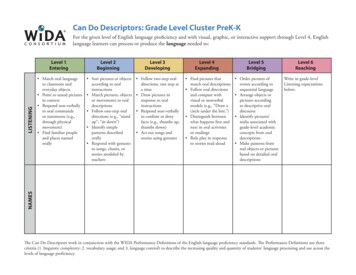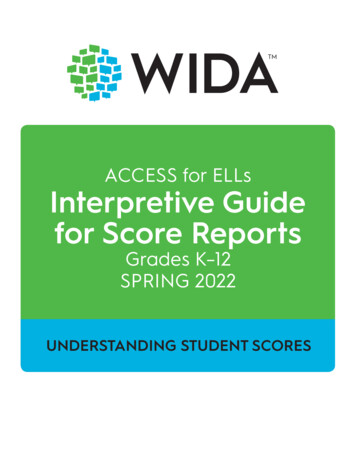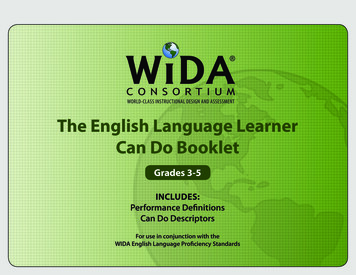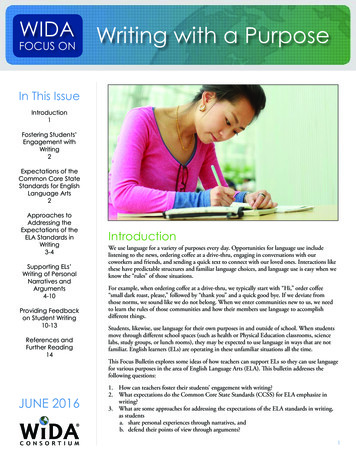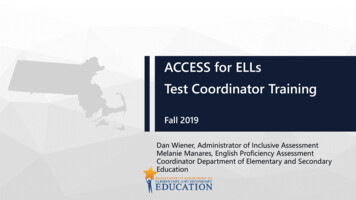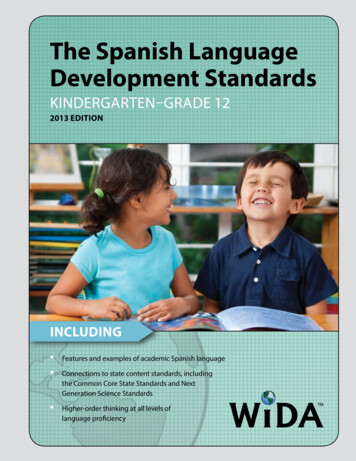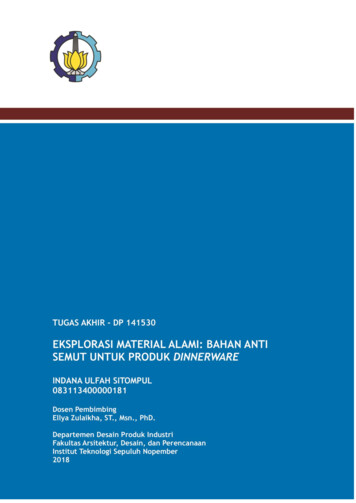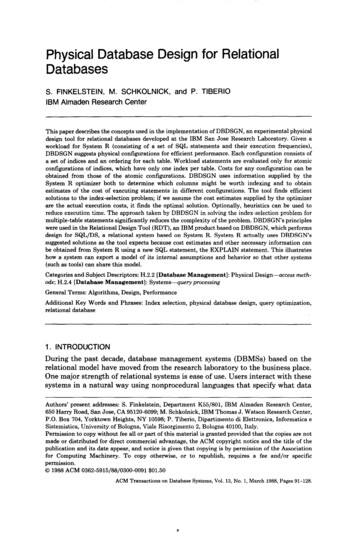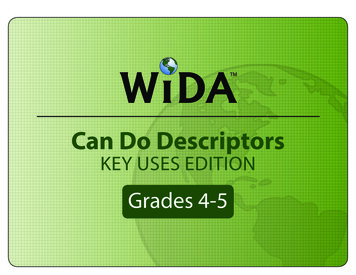
Transcription
Can Do DescriptorsKEY USES EDITIONGrades 4-5
DevelopmenSomplifyingci otexcultural Contothe WIDA Can DsphyniExplain: To clarify the “why” or the “how” of ideas, actions, or phenomena. Exampletasks for the Key Use of Explain include describing life cycles, sharing why or how thingswork, stating causes and effects, and sharing results of experiments.PerformanceDefinitionsStandards &their MatriceseExRecount: To display knowledge or narrate experiences or events. Example tasks for theKey Use of Recount include telling or summarizing stories, producing informationreports, and sharing past experiences.tenmThe WIDA Can Do Descriptors, Key Uses Edition provides examples of academic language use forfour specific communicative purposes. These purposes, referred to as Key Uses, were identifiedbased on reviews of literature and a language analysis of college and career readiness standards:es of Language DcipleveniPrlopginrpiaortepAcad-Apllyetauageangic LmThe WIDA Can Do Descriptors provide examples of what language learners can do at variousstages of English language development in listening, speaking, reading and writing. The WIDACan Do Descriptors, Key Uses Edition is one component of the WIDA Standards Framework(shown at right). The framework, as a whole, supports the implementation of the WIDA EnglishLanguage Development Standards in the instruction and assessment of language learners. Weencourage educators to use the WIDA Can Do Descriptors, Key Uses Edition in conjunctionwith the other components of the framework, along with the previous edition of the Can DoDescriptors. For more information on the WIDA Standards Framework, visit www.wida.us.GuidThe WIDA Can Do Descriptors, Key Uses Edition, Grades K–12siloPhoWIDA Standards FrameworkArgue: To persuade by making claims supported by evidence. Example tasks for the KeyUse of Argue include stating preferences or opinions and constructing arguments withevidence.Discuss: To interact with others to build meaning and share knowledge. Example tasks for the Key Use of Discuss include participating in small or largegroup activities and projects.The WIDA Can Do Descriptors, Key Uses Edition and the example descriptors are not exhaustive but are meant to help guide the planning and conversationaround meaningful participation of language learners in stardards-based contest curriculum, instruction, and assessment.2
Organization of the WIDA Can Do Descriptors, Key Uses Edition, Grades K–12The WIDA Can Do Descriptors, Key Uses Edition is organized by grade-level bands (K, 1, 2–3, 4–5, 6–8, and 9–12) that correspond to those in ACCESS for ELLs2.0. Within each grade-level band, the descriptors are organized by Key Use (Recount, Explain, Argue and Discuss) and within each Key Use, there are exampledescriptors for WIDA’s six levels of language proficiency (ELP Levels 1–6).The descriptors in Level 6 represent the language performance of students who have met all the criteria for Level 5. Unlike the descriptors at Levels 1–5 thatprovide examples of performance at the end of the level, the descriptors at Level 6 are examples of performance within Level 6.For three of the Key Uses (Recount, Explain, and Argue) you’ll see descriptors for the four language domains (Listening, Reading, Speaking, and Writing).The descriptors for the Key Use Discuss are only shown for oral language. The Key Use Discuss highlights the importance of oral language development formeaningful participation of all language learners, regardless of their level of language proficiency.Potential Uses for the WIDA Can Do Descriptors, Key Uses EditionAudiencesThe WIDA Can Do Descriptors, Key Uses Edition can help .Educators who work withlanguage learners, includingcoaches, teachers (e.g., generaleducation, gifted and talented,special education, Title I), languagespecialists, and support staff. Differentiate curriculum, instruction, and assessments designed in English based on language learners’ levels ofEnglish language proficiencyCollaborate and engage in instructional conversations about the academic success of language learners in EnglishenvironmentsAdvocate for equitable access to content for language learners based on their level of language proficiencyAdministrators and school leaders Communicate with other educators about students’ English language developmentSupport the WIDA Can Do Philosophy throughout schools and districtsAdvocate for equitable access to content for language learners based on their level of language proficiency Stakeholders are encouraged to use the Can Do Descriptors beyond the audiences and purposes identified above to advocate on behalf of language learners.3
By the end of each of the given levels of English language proficiency* English language learners can.LISTENINGSPEAKINGKEY USE OF RECOUNT4-5ELP Level 1EnteringELP Level 2EmergingELP Level 3DevelopingELP Level 4ExpandingELP Level 5BridgingELP Level 6ReachingProcess recounts by Matching oralwords and phrasesto content-relatedpictures or objects Identifying the topicin oral statementsProcess recounts by Classifying timerelated language inoral statements (e.g.,present, past, future) Connecting thecontext of narratives(e.g., the who, what,when, & where) toillustrationsProcess recounts by Identifying thebeginning, middleand end in oralretelling of a text Following tasks anddirections retold bypeersProcess recounts by Sequencing eventsor steps based onoral reading ofinformational text Recognizing thelanguage of relatedgenres (e.g., newsreports, historicalaccounts)Process recounts by Identifing relatedinformation frommultiple sourcespresented orally Recognizing the keyhistorical, scientificor technicallanguage used in amini-lectureProcess recounts by Identifying theoverall structure(e.g., chronology)of events, ideas,concepts, orinformation in oralpresentations Differentiatingsimilarities anddifferences ofinformationpresented throughmultimedia andwritten textRecount by Stating key wordsand phrasesassociated with thecontent using visualor graphic support Communicatingpersonal experiencesorallyRecount by Retelling shortstories or contentrelated events Stating proceduralsteps across contentareasRecount by Presenting detailedcontent-relatedinformation that hasbeen rehearsed Stating mainideas in classroomconversations onsocial and academictopicsRecount by Giving contentrelated oral reports Sequencing steps tosolve a problemRecount by Conveying personaland content-relatedexperiences in ateam Using technical andspecific vocabularywhen sharingcontent informationRecount by Summarizingdiscussions oncontent-relatedtopics Expanding on topicswith descriptivedetails using variedvocabulary*Except for Level 6, for which there is no ceiling.4
By the end of each of the given levels of English language proficiency* English language learners can.WRITINGKEY USE OF RECOUNTREADING4-5ELP Level 1EnteringELP Level 2EmergingELP Level 3DevelopingELP Level 4ExpandingELP Level 5BridgingELP Level 6ReachingProcess recounts by Identifying words incontext during oralreading of illustratedtext on familiartopics or experiences Highlightingpreviewed orfamiliar phrasesProcess recounts by Classifying timerelated language intext as present orpast Identifying the“who,” “what,”“where,” and “when”in narrative textwith a partnerProcess recounts by Sequencingevents in storiesor content-relatedprocesses Identifying mainideas in narrativeand informationaltextProcess recounts by Connecting detailsto main ideas orthemes Identifyingconclusions inmulti-paragraph textProcess recounts by Becoming familiarwith the languageof related genres(e.g., news reports,historical accounts) Summarizinginformation frommultiple relatedsourcesProcess recounts by Identifying theoverall structure(e.g., chronology)of events, ideas,concepts, orinformation in text Highlighting eventsor proceduresthat happened inhistorical, scientific,or technical textRecount by Communicatingpersonal experiencesthrough drawingsand words Reproducing a seriesof events throughillustrated textRecount by Listing proceduralsteps across contentareas Listing positiveand negativeeffects of events ininformational ornarrative textRecount by Using key wordsand phrasesreflective of mainideas Conveying detailsusing concretewords and phrasesRecount by Relating a sequenceof events usinga variety oftransitional words,phrases, and clauses Synthesizinginformation acrossrelated texts (e.g.,author study)Recount by Producing contentrelated reports Creating narrativesthat connectpersonal experiencesand contentRecount by Summarizingcontent-relatedinformation Using narrativethemes to extendthe storyline*Except for Level 6, for which there is no ceiling.5
By the end of each of the given levels of English language proficiency* English language learners can.SPEAKINGKEY USE OF EXPLAINLISTENING4-5ELP Level 1EnteringELP Level 2EmergingProcessexplanations by Sequencing oralprocedures or cycleswith images Distinguishingkey words andphrases related tophenomenaProcessexplanations by Organizing routinecausal or sequentialrelationshipsdescribed orally Following oraldirections to showrecurring steps incycles or problemsolvingExplain by Namingcomponents ofphenomena usingillustrations,photographs, ordiagrams Demonstratingprocedures usingrealiaExplain by Giving reasons whyor how somethingworks usingdiagrams, charts orimages Stating key words orphrases in processesin a sequential order*Except for Level 6, for which there is no ceiling.ELP Level 3DevelopingELP Level 4ExpandingELP Level 5BridgingELP Level 6ReachingProcessexplanations by Interpretingcause and effectrelationships inconversations Recognizingrelationships ina series of oralstatementsProcessexplanations by Identifying precisedetails, descriptions,or comparisonsthat supportconversation Following oralinformation on howor why phenomenaoccurProcessexplanations by Recognizinglanguage usedto enhance thespecificity ofphenomena in classdiscussions Identifyingcomponents ofsystems (e.g.,ecosystems, branchesof government)in small groupinteractionsProcessexplanations by Interpreting thespecific languageused to enhancedescriptions ofphenomena Attending to thelanguage relatedto events orphenomena in peerpresentationsExplain by Stating clearsequentialprocedures to peers Comparing data orinformationExplain by Connectingthe sequential,cyclical, or causalrelationships ofcontent-relatedissues and concepts Presenting detailedinformation in smallgroupsExplain by Elaborating byadding precisionand details tocontent-relatedsequence or causalphenomena Describingrelationshipsof componentswithin systems(e.g., ecosystems,government)Explain by Analyzing howvariables contributeto events oroutcomes Maintaining aformal register6
By the end of each of the given levels of English language proficiency* English language learners can.READINGWRITINGKEY USE OF EXPLAIN4-5ELP Level 1EnteringELP Level 2EmergingELP Level 3DevelopingELP Level 4ExpandingELP Level 5BridgingProcessexplanations by Matching illustratedwords/ phrases tocausal or sequentiallanguage Sequencingsentences strips toshow content-areaprocesses fromillustrated textsProcessexplanations by Identifying differenttypes of connectors(e.g., first, next,because, so) Identifying keywords and phrasesthat describe thetopic or phenomenaProcessexplanations by Matching causeswith effects Identifying wordsor phrases todetermine the typeof explanation (e.g.,linear sequence, cycle,system)Processexplanations by Identifying thedifferent words orphrases that are usedto describe the sametopic or phenomena Organizinginformation on howor why phenomenaoccurProcessexplanations by Identifying howtext provides cleardetails of the topicor phenomena Identifyingcomponents ofsystems (e.g.,ecosystems,government)Processexplanations by Identifying howtext presentsinformation in afactual or neutralmanner Evaluating thespecific languageused to enhancedescriptions ofphenomenaExplain by Producing shortanswer responsesto questions usingword/ phrase banks Labeling chartsand graphs todescribe phenomena(e.g., organisms inecosystems)Explain by Using keyterms related tophenomena Ordering linear andcyclical sequencesof phenomena (e.g.,the steps of how avolcano erupts)Explain by Connecting relatedideas or conceptsusing linking wordsand phrases Answering “how”or “why questions(e.g., “How does thewater cycle work?”“Why are therethree branches ofgovernment?”)Explain by Presentinginformationon processes orphenomena from avariety of sources Elaboratingtopics with facts,definitions,concrete details,or quotations andexamplesExplain by Describing howfactors contribute toevents or outcomes Describing howsystems relate orinteractExplain by Presentinginformationon processesor phenomenasupported by factsand details in essaysand reports Selecting theappropriateorganizationalstructure for theparticular purpose*Except for Level 6, for which there is no ceiling.7ELP Level 6Reaching
By the end of each of the given levels of English language proficiency* English language learners can.SPEAKINGKEY USE OF ARGUELISTENING4-5ELP Level 1EnteringELP Level 2EmergingELP Level 3DevelopingELP Level 4ExpandingELP Level 5BridgingELP Level 6ReachingProcess arguments by Matchingillustrations withoral points of view Identifying languagerelated to facts oropinions from oralpresentationsProcess arguments by Sorting evidenceand claims from oraldescriptions Distinguishingwords and phrasesrelated to opinionsor facts from oralstatementsProcess arguments by Identifying differentperspectives, stances,or points of view Recognizing reasonsfor positions in oralpresentationsProcess arguments by Identifying evidencethat supportspredictions orhypotheses Differentiatingbetween multiplepoints of view inclass discussionsProcess arguments by Distinguishingcertainty fromuncertainty ofspoken words orphrases in context Identifying thedegree of formalityin oral presentationsProcess arguments by Recognizing thestrength of thequality of evidencepresented in oraldiscourse Identifyingthe purpose ofargumentsArgue by Stating reasons forchoices using wordsor phrases Answering yes/noor choice questionsacross content orpersonal preferencesArgue by Stating opinionsbased on experiences Responding toopinion statementsof others withpersonal preferencesArgue by Expressing opinionsusing content-areaspecific language Presenting contentbased facts thatsupport a positionArgue by Stating relevantevidence for claims Responding toopinion statementsof others withreasons or evidenceArgue by Supporting claimswith evidence fromvarious sources Using claims andevidence to persuadean audienceArgue by Countering with adifferent point ofview Stating conclusionsbased on a summaryof information fromthe various sides*Except for Level 6, for which there is no ceiling.8
By the end of each of the given levels of English language proficiency* English language learners can.WRITINGKEY USE OF ARGUEREADING4-5ELP Level 1EnteringELP Level 2EmergingELP Level 3DevelopingELP Level 4ExpandingELP Level 5BridgingELP Level 6ReachingProcess arguments by Identifying keywords and phrasesof claims Identifying a claimor an opinion inmultimedia with apartnerProcess arguments by Identifying languageindicative of pointsof view Organizing evidencebased on sequentiallanguage in texts Differentiatingbetween claims andevidenceProcess arguments by Identifying evidencefrom multiple placeswithin text Identifying differentperspectives, stances,or points of viewProcess arguments by Hypothesizing orpredicting based onevidence Comparing multiplepoints of view on atopicProcess arguments by Connectingpersonal experiencewith textualevidence tostrengthen aninterpretation of thetext Evaluating thestrength of evidenceas support for claimsProcess arguments by Evaluating claimsand evidence bydrawing frommultiple printsources Differentiatingfrom the strength ofdifferent pieces ofevidence as supportfor claimsArgue by Selecting words andphrases to representpoints of view usingfacts from illustratedtext or posters Using key words orphrases related tothe topicArgue by Stating reasons forparticular points ofview Listing pros andcons of issuesArgue by Connectingreasons to opinionssupported by factsand details Making adjustmentsfor audience andcontextArgue by Comparing andcontrasting evidencefor claims Providing reasonsand evidence whichsupport particularpointsArgue by Evaluating positiveand negativeimplicationsassociated withvarious positions(e.g., historicalevents, scientificdiscoveries) Including evidencefrom multiplesourcesArgue by Organizing ideasand informationlogically andcoherently Integratinginformation frommultiple sources toprovide evidence forclaims*Except for Level 6, for which there is no ceiling.9
By the end of each of the given levels of English language proficiency* English language learners can.ORAL LANGUAGEKEY USE OF DISCUSS4-5ELP Level 1EnteringELP Level 2EmergingELP Level 3DevelopingELP Level 4ExpandingELP Level 5BridgingELP Level 6ReachingDiscuss by Expressing ownideas in a variety ofways (e.g., drawing,using gestures,graphing) Tracking the personspeaking Sharing ownwork (e.g., graphicorganizers, drawings)to contribute to theconversationDiscuss by Taking turnsand applyingconventions specificto particularconversations Addressing othersaccording torelationship (e.g.,student-peers,student-teacher)Discuss by Asking clarifyingquestions todemonstrateengagement Using examples toclarify statements Answering questionsto contribute to atopicDiscuss by Elaborating onstatements of othersto extend ideas Presenting creativesolutions to resolvecommunicationissues Contributing ideasto co-create groupresponsesDiscuss by Recognizing howlanguage can beused to express biasand influence others Challenging ideasrespectfully Managingconversations to stayfocused on a topicDiscuss by Examining the valueof examples to bringclarity to statements Extendconversations bydeveloping topicswith clear examplesand information*Except for Level 6, for which there is no ceiling.10
Copyright Notice 2016 Board of Regents of the University of Wisconsin System, on behalf of WIDA. The WIDA Can Do Descriptors, Key Uses Edition, Grade4–5, (“Can Do Descriptors”) may not be reproduced, modified, or distributed without prior written permission from WIDA. The WIDA Can DoDescriptors, Key Uses Edition, Grade 4–5 is for your personal, noncommercial use only. Fair use of the WIDA Can Do Descriptors, Key Uses Edition,Grade 4–5 includes reproduction for the purpose of teaching (including multiple copies for lesson planning).To order more copies of this booklet, please visit the WIDA Store at https://www.wceps.org/Store/WIDA or call toll free 1- 877-272-5593 ore-mail store@wceps.org.AcknowledgementsThe development of the Can Do Descriptors represents the work of many educators in the field. WIDA would like to extend its appreciationto everyone who contributed through their expertise to this work, including the staff at the Center for Applied Linguistics for their ongoingpartnership and support.Please visit www.wida.us to view a full list of educators who participated on the development workshop, national experts who shared their expertisein the development process, and those who participated in the review of the Can Do descriptors.Version 1.1 8/1/16
2016 Board of Regents of the University of Wisconsin System, on behalf of the WIDA Consortiumwww.wida.us
Organization of the WIDA Can Do Descriptors, Key Uses Edition, Grades K-12 The WIDA Can Do Descriptors, Key Uses Edition is organized by grade-level bands (K, 1, 2-3, 4-5, 6-8, and 9-12) that correspond to those in ACCESS for ELLs 2.0. Within each grade-level band, the descriptors are organized by Key Use (Recount, Explain, Argue and Discuss) and within each Key Use, there are example
